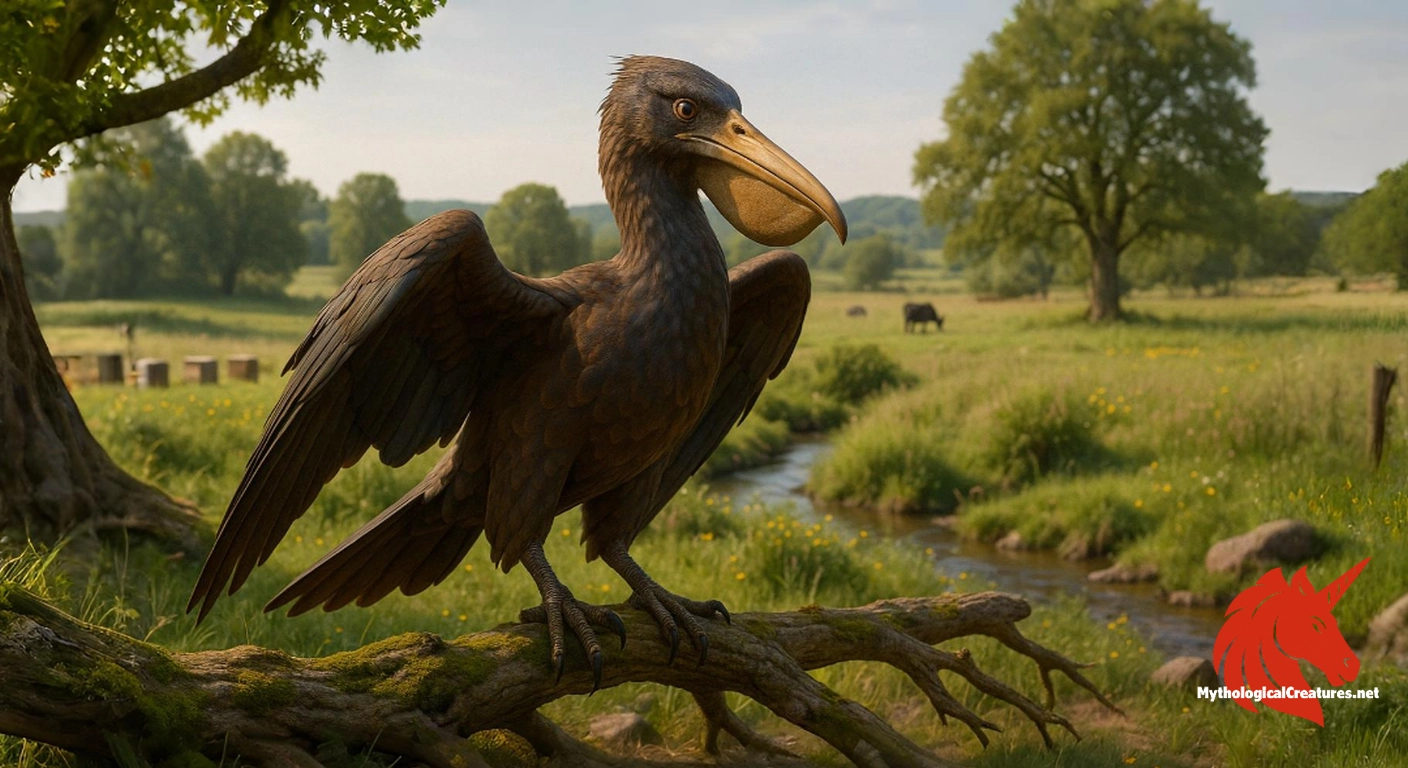Cikavac: Cikavac is a winged mythical bird from Serbian folklore known for its long beak and pelican-like sack.

Cikavac
Cikavac - Represents the transformative power of forbidden rituals and the rewards of adhering to folk taboos
Origins & First Encounters
The Cikavac occupies a singular place in Serbian mythology as an enigmatic, winged creature that embodies the interplay between the natural and the supernatural. It is said to originate from mystical rites, with its creation linked to a ritual involving a black hen’s egg, symbolising the union of life and magic. This creature is deeply embedded in the cultural tapestry of the Balkans, emerging in oral traditions that have been passed down through many generations. Its early attestations suggest that it was not merely a figure of wonder but a practical symbol of fortune and otherworldly favour. The legend of the Cikavac reflects a time when natural phenomena were interpreted through the lens of spirituality and enchantment. With its association with specific rituals and taboos, such as abstaining from confession and personal grooming, the Cikavac also underscores the intimate link between human behaviour and magical outcomes. Regional narratives attribute to it the power to fulfil wishes, thereby establishing it as a benevolent yet formidable force. The creature’s ability to bestow the gift of understanding animal language further cements its role as a mediator between the human and animal worlds. Its mystique continues to intrigue those who study folklore, representing a bridge to a past where myth and ritual were inseparable aspects of everyday life.
Source Texts & Tale Variants
The primary records of the Cikavac are primarily preserved in the rich oral tradition of Serbian folklore, where its story has undergone various adaptations over time. Many narratives detail its origin story and the elaborate process by which it may be acquired, often involving a set of strict behavioural prohibitions during a mystical 40-day period. While the earliest sources remain diffuse and part of communal storytelling, later collectors have recorded these tales in folk anthologies and regional manuscripts. Some variants recount the creature’s role in encouraging secrecy, ritual purity, and the mystical exchange between owner and beast. Oral historians have often stressed the element of transformation, whereby a simple black hen’s egg becomes the genesis of a creature with substantial magical abilities. Literary renditions expand on the fascinating rituals and symbolic meanings attached to the Cikavac, enriching its character beyond the literal. The storytelling is characterised by its rhythmic narrative style and its fusion of moral and ritualistic codes. Variations in the tale emphasise different aspects of its power, from controlling nature by extracting honey and milk to enabling communication with the animal realm. These diverse versions contribute to a complex mosaic of myth that has evolved with each retelling.
Form & Powers
The Cikavac is classically depicted as a winged creature, its form reminiscent of a bird yet imbued with features that defy ordinary classification. It possesses an elongated, curved beak that is both elegant and slightly menacing in its design, while a pelican-like sack augments its mysterious appearance. The creature’s plumage is often imagined as variegated in shades that might blend with dusk or dawn, reflecting a natural yet supernatural beauty. Its wings are robust and expansive, suggesting both grace in flight and the latent power contained within its form. Some descriptions hint at subtle, almost ethereal luminescence, further distinguishing the Cikavac from mundane birds. In addition to its striking beak and pouch, its eyes are sometimes portrayed as keen and reflective, symbols of an insight that transcends the ordinary. The size of the Cikavac may vary in different accounts, with some suggesting that it is modest in scale while others attribute it with a grandeur that borders on the majestic. Detailed portrayals frequently merge realistic avian traits with fantastical elements, thereby creating a being that is both familiar and wondrous. Its physicality, while diverse in interpretation, consistently serves as a visual metaphor for the transformative magic inherent in its legend.
Regional Faces
Throughout the Balkan region, variations of the Cikavac myth have emerged that reflect local cultural nuances and environmental influences. In some parts of Serbia, the creature is portrayed with a darker, more cautionary aura, symbolising the perils of straying from traditional rites and rituals. Other communities imbue it with a more benevolent character, stressing its role as a guardian of nature and a harbinger of prosperity. These regional adaptations often include slight differences in the ritualistic process required to harness its power, with diverse taboos and timeframes that underscore local beliefs. Certain areas emphasise the aspect of animal communication, while others highlight the creature’s ability to extract sustenance from communal resources like honey and milk. This multifaceted regional portrayal indicates that the Cikavac has served multiple symbolic functions over time. Local storytellers have tailored the myth to resonate with the immediate experiences and values of their communities, thereby ensuring its continued relevance. The regional narratives sometimes blend elements of cautionary folklore with uplifting promises of fulfilment, illustrating the dual nature of magic as both a benevolent and unpredictable force. Such variations attest to the adaptive nature of myth, where each culture reshapes the tale to best reflect its own social and spiritual landscape.
Cultural Parallels
A comparative analysis reveals that the Cikavac shares significant thematic elements with other mythical creatures found in diverse cultural traditions. Like many familiar spirits and magical familiars in European folklore, it is a creature borne of magical ritual, an intermediary between the human and natural realms. Similar to the fae or other supernatural birds in various mythologies, the Cikavac is associated with the vital forces of nature, acting as a conduit for prosperity and the fulfilment of wishes. The concept of a creature that can be summoned or nurtured through specific rites finds echoes in other cultural practices across Eastern and Central Europe. In many traditions, the possession of such a being is linked to attaining secret knowledge, particularly the ability to communicate with animals or understand natural sounds. Its dual nature of being both a helper and a symbol of the mystical comes close to the roles played by other legendary entities like the phoenix or the griffin, albeit with uniquely local attributes. Comparative mythology often highlights how such beings epitomise the human desire to harness and direct the natural world through ritual and belief. In assessing these parallels, one can appreciate the universal themes of transformation, transgression, and transcendence that permeate folklore across continents. The Cikavac, in this light, stands as a culturally specific yet thematically resonant example of magical fauna.
Legacy & Modern Evolution
The historical evolution of the Cikavac myth reflects broader shifts in the perception of the supernatural within Serbian cultural history. While early depictions imbued it with a potent sense of magic and moral admonition, later renditions have focused more on its allegorical and symbolic aspects. The ritualistic origins have gradually become embedded in a narrative that highlights the interplay of human desire, nature, and the mysterious. In modern times, the Cikavac has been reinterpreted in literature and popular culture, often serving as a symbol of the forgotten or repressed magic of the past. Contemporary artists and writers sometimes evoke its image to critique modernisation and the loss of traditional wisdom. This adaptation in modern storytelling has helped to preserve the creature’s legacy while inviting new audiences to explore its rich historical context. Its myth has found a place in discussions on folklore preservation and the importance of cultural heritage in a rapidly changing world. As scholarly interest in myth and magical realism grows, the Cikavac stands as a testament to the enduring power of oral tradition and the transformative nature of myth. Across centuries, it has maintained a dual role as an emblem of wonder and a reminder of the complex relationship between humanity and the natural world.
Interesting Fact
The ritual required to acquire the Cikavac highlights the belief in transformation through taboo acts, showcasing how everyday elements can become imbued with magical power in Serbian mythology.
Quick Creature Info
Features:
Associations:
Our Mythic Legendary Rating:

Habitat:
Supernatural Powers:
Physical Attributes:
Abilities:
Behavior:
Lore:
References
Discover Another Mythical Legend You May Not Have Heard Of?
Uncover the mysteries of ancient folklore and expand your knowledge of legendary beings from cultures around the world.
Dare to Meet the Andvari....
Mythical Disclaimer: The images and data on this site are derived from various historical and literary sources, but we have found that many myths often have multiple versions and interpretations across references, sometimes contradictory. As a result, these creature depictions are artistic interpretations—imaginative blends of folklore, legend, and a dash of AI guesswork. Because creature descriptions vary widely, our illustrations and accompanying information represent our best effort to honor mythology while bridging creative gaps. Enjoy these interpretations—just remember, we've done our best to respect the stories and validate available data, but in the realm of mythology, details often shift, imagination leads the way, and nothing is ever set in stone!
Curated by the Mythological Creatures Team (rev. May 2025)
